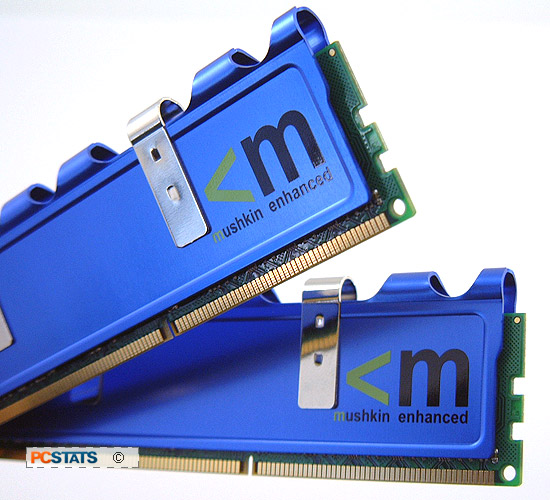It's great
to see how individual memory stacks up against the competition under stock
configurations, but we're also going to show how it compares when overclocked.
With performance in mind, we're going to compare the maximum overclocked results
of the various DDR2/3 memory modules PCSTATS has tested in the past which are
listed below. Remember, just because memory is clocked fast doesn't mean it's
the best thing for a computer. Timings are also important, and getting the right
ratio of both is the real key to performance based overclocking!
* - denotes tested on ECS PN2 SLI2+ platform
The most
significant aspect of Mushkin's 2GB HP3-10666 memory kit is that it runs with
tight 6-7-6-18 timings. No other DDR3 memory we've tested can do that, so while
it trails in the maximum overclocking chart in terms of clock speed, the
benchmarks tell a completely different tale.
Mushkin is going in another
direction with DDR3

Mushkin is taking an independent route when it comes to
its new enthusiast grade DDR3 memory - the HP3-10666 modules.
While many memory companies are trumping high speeds,
Mushkin know that CAS latency memory timings often play a bigger role in
application performance. To that effect, PCSTATS is pleased to have tested this
pair of low latency DDR3 memory.
It's the first low latency DDR3 on the market we're aware
of in fact.
The 2GB Mushkin HP3-10666 memory might not be able to
clock super high, but enthusiasts will definitely take notice of the stock
6-7-6-18 CAS Latency memory timings.
If you've been around the overclocking scene long enough,
you'll no doubt know the value of low latencies. If not, you need only look back
over the benchmarks.
PCSTATS memory benchmarks show a difference between the
other DDR3 memory tested and the Mushkin HP3-10666 memory. That difference
resides with the latency of the memory, so for example SiSoft Sandra reported
more memory bandwidth. The WinRAR compression test illustrated the point yet
again. In gaming benchmarks, 3DMark06 results were a toss up - all DDR3 memory
modules performed the same. However, in Doom 3 and FEAR, the Mushkin HP3-10666
memory was in the lead.
When Mushkin's HP3-10666 memory was overclocked with those beautiful lax timings, it had
problems beating its stock performance! That tells
you how fast good DDR3 memory can handle with quick timings. Yes timings are
that important. PCSTATS talked about this back in the DDR-days and the general
rule of thumb still applies with DDR3 memory.
When memory manufacturers choose to go with memory that
can run tight timings, speed is often sacrificed. This is the case with the
Mushkin HP3-10666 memory. With the tight timings, the DDR3 memory was only able
to hit 1452 MHz and even with the timings relaxed to 8-8-8-24, the memory only
overclocked to 1760 MHz.
Even though the Mushkin HP3-10666 DDR3 memory is not the
highest speed DDR3 memory PCSTATS has tested, that doesn't mean it's slow. In
fact far from it, enthusiasts will quickly recognize the value of tight timings
and in all honestly I wish more manufacturers would follow Mushkin's lead here.
High speeds are great, but it's no good when timings are thrown out the window.
Hopefully Mushkin can get these awesome DDR3-1333 memory modules out on the
streets quickly because I expect many overclockers will be interested in
them!
Find out
about this and many other reviews by joining the Weekly PCstats.com
Newsletter today! Catch all of PCSTATS latest reviews right here.
Related Articles
Here are a
few other articles that you might enjoy as well...
- OCZ PC2-9200 FlexXLC 2GB Dual Channel Memory Review
- Super Talent W1866UX2G8 DDR3-1866 Memory Review
- Microsoft Windows Vista: How much memory is enough?
- Corsair DOMINATOR Twin3X2048-1800C7D 2GB DDR3-1800 Memory
Kit Review
- Microsoft Windows Vista & ReadyBoost: Does it Make a
Difference?
